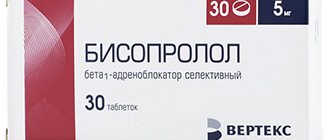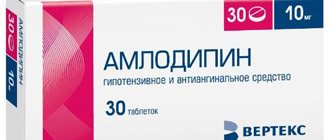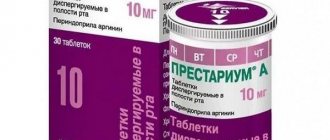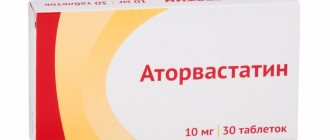0
Author of the article: Marina Dmitrievna
2017.11.28
584
Drugs
Many people, especially those who have reached old age, suffer the most from improper functioning of the cardiovascular system. As a rule, this unpleasant condition provokes the development of many serious diseases. To minimize the risk of developing such a situation, many specialists prescribe the drug Tonorma.
Tonorma
Pharmacodynamics and pharmacokinetics
A drug with a combined composition. The main effect is antihypertensive. The mechanism of action is due to the pharmacological properties of its components.
Atenolol is a β-adrenergic receptor and has antihypertensive and antianginal effects. Atenolol reduces heart rate , both during exercise and at rest, automatism of the sinus node, excitability and contractility of the myocardium, and reduces the need of the heart muscle for oxygen. slows down AV conduction .
Nifedipine - belongs to the dihydropyridine , a calcium channel blocker. Inhibits the process of calcium ions entering the cell, mainly into vascular smooth muscle cells. It has a pronounced antihypertensive effect, dilates the coronary vessels, which reduces the afterload on the heart and its need for oxygen, and improves blood supply to the myocardium. When combined with nifedipine, the antihypertensive effect is enhanced.
Chlorthalidone is a benzothiadiazine , a highly active diuretic. Blocks the reabsorption of sodium in the convoluted tubules of the kidneys, while chloride and sodium ions are excreted from the body in equivalent quantities.
It has a weakly expressed kaliuretic effect.
Pharmacokinetics
Atenolol is absorbed in the gastrointestinal tract at a level of 50–60%. Communication with blood proteins is low. Does not penetrate the blood-brain barrier , but easily overcomes the placental barrier and enters breast milk. T½ about 7 o'clock. The pharmacological effect lasts about one day. It is excreted unchanged through the kidneys.
Nifedipine is rapidly absorbed when taken orally. T½ 3 hours. Cmax in the blood after administration is reached within 40 minutes. It is excreted primarily in urine in the form of inactive metabolites.
Chlorthalidone - when taken orally, it is well absorbed from the gastrointestinal tract , absorbed on the surface of red blood cells, and the connection with blood proteins is low. The diuretic effect appears after 3 hours and lasts for 24 hours, sometimes more. Excreted through the kidneys and intestines.
Overdose of the drug Tonorma, symptoms and treatment
Symptoms : the clinical picture depends on the degree of intoxication and is manifested mainly by cardiovascular and central nervous system disorders. Overdose can lead to arterial hypotension, bradycardia, heart failure and cardiogenic shock. In severe cases, respiratory failure, bronchospasm, vomiting, and impaired consciousness are observed; extremely rarely - generalized convulsive attacks. Treatment: in case of overdose or with a threatening decrease in heart rate and/or blood pressure, treatment with Tonorma is stopped. In intensive care units, vital signs should be closely monitored and adjusted if necessary. If necessary, prescribe:
- atropine (0.5–2 mg IV bolus);
- glucagon: initial dose 1–10 mg IV (boost), subsequently 2–2.5 mg/hour as a continuous infusion;
- sympathomimetics depending on body weight and effect (dopamine, dobutamine, isoprenaline, oxyprenaline or adrenaline).
If drug treatment for bradycardia is not effective, cardiac pacing may be performed. For bronchospasm, β2-sympathomimetics are prescribed in the form of an aerosol (if the effect is insufficient, also IV) or aminophylline IV. For generalized convulsions, slow intravenous administration of diazepam is prescribed.
Side effects
General weakness, sleep disturbances, depression , hallucinations , confusion ; disturbances in concentration, paresthesia in the extremities, bradycardia , dry mouth, nausea, constipation, pancreatitis , hyperglycemia , thrombocytopenia , local allergic reactions, fatigue, photosensitivity, flushing , increased sweating.
Overdose
If a patient drinks a large dose of Tonorma, the functionality of the central nervous system and cardiovascular system malfunctions, cardiogenic shock develops, and blood pressure and heart rate drop sharply.
The severity and negative impact of an overdose on the body depends on the number of tablets taken.
A severe overdose can cause breathing problems, vomiting and loss of consciousness. Convulsions and bronchial spasms rarely develop.
In case of Tonorma poisoning, the following measures should be taken:
- In case of bradycardia and blood pressure surges, immediately stop using the drug.
- For convulsive attacks - intravenous administration of Diazepam.
- Aminophylline infusions are used to prevent bronchospasm.
- Heart rate is restored by electrical pacing.
- To restore glucose concentration, use an injection or infusion of Glucagon.
- Some patients are prescribed the following drug combinations: Atropine/Oxyprenaline, Dopamine/Dobutamine, Adrenaline/Isoprenaline.
Interaction
When Tonorma is taken together with antidiabetic drugs and insulin , their sugar-lowering effect is enhanced. With the simultaneous use of the drug with antihypertensive drugs of different groups, the hypotensive effect of such drugs is enhanced. The effect of atenolol is enhanced when taken together with anesthesia. When prescribing Tonorma with clonidine , reserpine , verapamil or methyldopa, there is a risk of developing severe bradycardia .
When taking the drug together with alcohol or psychotropic drugs (tranquilizers, sleeping pills, antipsychotics, antidepressants), the hypotensive effect may be enhanced. Atenolol may potentiate the effect of indirect anticoagulants and reduce the bronchodilator effectiveness of sympathomimetics. It is not recommended to prescribe Tonorm together with MAO inhibitors . The simultaneous use of Tonorma with grapefruit juice increases the concentration of nifedipine and, due to a decrease in its metabolism, increases the hypotensive effect.
Contraindications to the use of the drug Tonorma
- the first 8 days after myocardial infarction;
- acute heart failure;
- cardiogenic shock;
- AV block II and III degrees;
- severe renal dysfunction, anuria, severe liver dysfunction;
- sick sinus syndrome;
- sinoatrial block;
- sinus bradycardia; (heart rate less than 50 beats/min);
- arterial hypotension (systolic pressure less than 90 mm Hg);
- BA;
- metabolic acidosis;
- late stages of peripheral circulatory disorders;
- simultaneous use of MAO inhibitors (with the exception of MAO-B inhibitors);
- hypersensitivity to other components of the drug;
- severe renal dysfunction, anuria.
Reviews about Tonorm
Reviews of Tonorma among patients taking the drug are mostly positive.
“... I have suffered from hypertension for more than 20 years. She was treated with many medications. Three months ago, the doctor suggested trying the drug Tonorma. After the course of treatment, the pressure became more or less stable, there were no sudden changes, my head became clearer and there were no severe headaches.”
According to doctors, Tonorma is a fairly effective antihypertensive drug. Its use provides a significant reduction in blood pressure , a decrease in LV and an improvement in intracardiac hemodynamics. The drug is well tolerated by patients, there are no negative changes in the biochemical parameters of urine and blood.
Special instructions for the use of the drug Tonorma
The drug should be prescribed with caution to patients with diabetes mellitus ((control of blood glucose levels), patients with AV block of the first degree, patients with gout, with impaired liver function, kidney function, Raynaud's disease, patients with obliterating diseases of the peripheral arteries. The drug should be prescribed with caution to patients with psoriasis, depression, elderly patients, with water-electrolyte imbalance. Treatment with Tonorma should not be stopped abruptly, as it can cause increased attacks of angina, in some cases myocardial infarction may develop (withdrawal syndrome). The drug should be stopped 48 hours before surgery intervention, which is planned to be carried out using general anesthesia. During treatment, it is necessary to stop drinking alcohol. Use during pregnancy and lactation. The use of the drug Tonorma is contraindicated during pregnancy and lactation. Children . The drug is not prescribed to children under 16 years of age. Ability influence the speed of reactions when driving vehicles or working with other complex mechanisms. During treatment, it is not recommended to drive vehicles or operate other complex machinery.
Tonorma price, where to buy
The price of Tonorm tablets No. 10 varies between 185 - 220 rubles per pack: No. 30 - 550-600 rubles. In most pharmacies in Moscow, you can buy Tonorm only by pre-order or purchase its structural analogues.
- Online pharmacies in RussiaRussia
- Online pharmacies in UkraineUkraine
LuxPharma* special offer
- Tonic tab.
N30 1400 rub. order
show more
Pharmacy24
- Tonorma No. 10 tablets PrAT" Pharmaceutical company "Darnitsa", Ukraine
37 UAH. order - Tonorma No. 30 tablets PrAT” Pharmaceutical company “Darnitsa”, Ukraine
106 UAH order
Mode of application
Tonorma is taken orally. The tablet is absorbed entirely, does not bite or dissolve, and is washed down with plenty of clean water. The dosage of the drug and the duration of treatment are prescribed by the doctor. The patient feels relief a few hours after taking Tonorma. The effect of the medication lasts about a day.
Important! Take the drug at one time.
Oral method of administration
TONORMA: a triple blow to arterial hypertension
Almost all publications about drugs intended for the treatment of patients with arterial hypertension begin with data on the prevalence of this disease and its complications. Probably, more than once, readers of the PHARMACEUTICAL WEEKLY have come across such statements as: “Arterial hypertension, due to its prevalence, is a global health problem” or “Arterial hypertension is the main risk factor for cardiovascular morbidity and mortality.” Many of us, reading these phrases, do not think about what stands behind them: the lives of people, perhaps those closest to us. How often do you have to give advice to a neighbor or friend regarding antihypertensive drugs, and how often does the pharmacist have to dispense these medications? Answer: daily and hourly. Hypertension is a condition that is widespread throughout the world, and it is likely that its prevalence will increase due to demographic changes, even in the absence of other causes. The aging population in Ukraine, alas, is an objective reality. And, as you know, arterial hypertension occurs in most elderly people.
Currently, experts have no doubt about the need for long-term, essentially lifelong drug therapy for arterial hypertension. And if for a mild course of the disease one drug may be enough, then for moderate or severe arterial hypertension, as a rule, two or more are required. According to the recommendations of specialists, if monotherapy is ineffective, the dose should not be increased to the maximum, as this increases the likelihood of side effects. It is better to use a combination of two, and if necessary, three medications. According to the most conservative estimates, combination treatment should be carried out in 50-70% of patients with arterial hypertension. However, using multiple drugs is not always convenient. And if the patient has to take them 2 or 3 times a day, then this is associated with the patient’s refusal of treatment or a violation of the treatment regimen. It is during this period that hypertensive crises and such dangerous complications of arterial hypertension as cerebral stroke or myocardial infarction can develop. Taking this into account, cardiologists came to the conclusion that the treatment regimen should be simple, if possible - according to the principle of “one tablet per day” (Svishchenko E.P., Kovalenko V.N., 2001). This increases the number of those patients who comply with the prescribed treatment regimen and reduces the number of those patients who stop taking antihypertensive drugs. Doctors also advise giving preference to long-acting drugs. This prevents significant fluctuations in blood pressure levels during the day, which lead to a significant increase in the risk of developing life-threatening conditions - myocardial infarction and cerebral stroke. In addition, the number of medications taken is reduced.
Pharmaceutical specialists together with employees of the Institute of Cardiology named after. N.D. The Strazhesko Academy of Medical Sciences of Ukraine took into account all the requirements and principles of treating patients with arterial hypertension when developing the antihypertensive drug TONORMA. This is an original combination of atenolol (100 mg), nifedipine (10 mg) and chlorthalidone (25 mg), which successfully combines the therapeutic advantages of each of these drugs and has no analogues on the Ukrainian pharmaceutical market.
What are the pharmacological properties and clinical advantages of this drug? The antihypertensive effect of the drug is due to the mechanism of action of its components. Since the components of the drug TONORMA belong to different classes of antihypertensive drugs and affect different parts of the pathogenesis of the disease, its use is especially relevant in patients with severe arterial hypertension, in whom combination therapy is often necessary to adequately control blood pressure.
In addition, TONORMA has a long-lasting (up to 24 hours) antihypertensive effect, allowing reliable control of blood pressure when taking the drug only once a day, and increases patient adherence to long-term treatment. Is it worth doubting the quality of a drug if it is produced by the flagship of the domestic pharmaceutical industry, the production conditions and quality control system of which meet the strictest GMP requirements? And the results of studies of the effectiveness and tolerability of the drug TONORMA, conducted at the Institute of Cardiology named after. N.D. Strazhesko AMS of Ukraine and the Department of Propaedeutics of Internal Diseases No. 1 of the National Medical University named after. A.A. Bogomolets, indicate that it is an effective and safe antihypertensive drug.
Thus, the advantages of using the combined drug TONORMA in patients with arterial hypertension are obvious. In addition to its high antihypertensive effectiveness and good tolerability, confirmed in the mentioned clinical studies, this drug is convenient to use, as it can replace several antihypertensive drugs of different classes. Instead of several single drugs, the patient only needs to take 1 tablet of the combined drug TONORMA. Obviously, this approach to therapy makes it much easier for patients to comply with the prescribed treatment regimen, and therefore increases its effectiveness. Thanks to the successful combination of high efficiency, quality and affordable price for a wide range of patients, the drug TONORMA is highly valued by specialists and patients, which has allowed it to take its rightful place in the pharmaceutical market of Ukraine. It is enough to look at the sales dynamics of TONORMA, even over a short period of time, to make sure that the drug is in demand (figure).
| Drawing. Sales volume of the drug TONORMA in physical terms in July-November 2005. |
In general, the reviews of those specialists who used various antihypertensive drugs in search of the optimal one can be summarized as follows: TONORMA “works”!
The WHO Atlas of Heart Disease and Stroke notes that high blood pressure is one of the most important preventable diseases
causes of premature death worldwide (Mackay J., Mensah G., 2004). In this regard, the role of pharmacists and pharmacists comes to the fore. After all, they are often the first people patients turn to for help and can recommend a drug based on their knowledge. Therefore, it is worth recalling that TONORMA is a combination antihypertensive drug with a triple mechanism of action that has no analogues. Taking only 1 tablet of the drug once a day allows you to reliably control blood pressure even in patients with severe arterial hypertension. I would like to emphasize once again that TONORMA is an affordable modern antihypertensive drug. This circumstance is of no small importance in cases where it is necessary to choose a drug for long-term therapy. Make sure that TONORMA is always in your pharmacy, it’s so simple. Remember, timely and correctly treated arterial hypertension saves a life. And you can save this life.
Materials prepared by Oleg Mazurenko
Brief instructions for choosing analogue drugs:
- Analogs must have equivalent active ingredients. To find a drug, use the service for selecting analogues by INN.
- The dosage of the analogue should be either the same or less. If the dosage is less, the medication regimen changes.
- The packaging of analogues may differ. Before purchasing, calculate how much of the drug is needed for the course of treatment.
- Analogs must have the same dosage form and route of administration. That is, you should not buy tablets instead of suppositories.
- Keep in mind that not all generic drugs are equally similar to the original drug.
- Do not replace the medicine with a dietary supplement.
Read more below.
Active substance
Each medicine has several names:
- trade
- international nonproprietary (INN) or grouping, or chemical
Trade name
unique for each manufacturer. It is necessary to distinguish drugs from different manufacturers.
Example of trade names of drugs containing the active substance ibuprofen:
- Dolgit
- Nurofen
- Ibuprofen-Akrikhin
- Faspik
- Mig and others
INN
is the name of the active substance.
An example of an active substance and a preparation containing it:
- ibuprofen (Nurofen, Mig)
- doxycycline (Unidox Solutab, Doxylan)
- acetylsalicylic acid (Aspirin, Upsarin UPSA)
Group name
assigned to a medicinal product if it does not have an INN or several of them.
Examples of group names:
- chondroitin sulfate
- tolperisone + lidocaine
- cod liver oil
Chemical name
- the name of the active substance, reflecting its composition and chemical structure.
The doctor must write a prescription in Latin using the INN. If there is no INN, the prescription is written by generic or chemical name. The drug is prescribed by its trade name if it does not have an INN, generic or chemical name.
The pharmacy employee offers you medications with the active ingredient that the doctor indicated in the prescription. Drugs with the same active ingredient can be produced by different factories. In this case, they will have different trade names.
Analogs must have equivalent active ingredients. To find a drug, use the service for selecting analogues by INN.
Medicine or dietary supplement
Prescribed medications cannot be replaced with dietary supplements. Dietary supplements do not have a therapeutic effect, but are indicated for use as an additional source of any substances for consumption along with food.
Dietary supplements should not be used as primary treatment. They may contain the same ingredients as medications. However, medicines and dietary supplements undergo different tests for state registration.
When choosing drug analogues, you should pay attention to the name of the drug, namely the active substance. The analogue should be selected taking into account the dosage, course of treatment and dosage form. It is important to pay attention to the manufacturer and whether the chosen product is a medicinal product.
There are contraindications. Possible side effects. Before use, you should consult a specialist.
Analogues of Tonorma
If the patient cannot treat hypertension with Tonorma, a specialist can prescribe an analogue. According to patient reviews, the most effective include:
- Beta Azomex.
- Amlodak-At.
- Logimax.
- Stamlo-Met.
- Alotendin, instructions for use.
- Neocard-Atn.
- Amlong-A.
In Russian pharmacies, these drugs can be purchased at a favorable price only with a prescription. At the moment, there is no effective Russian analogue of Tonorma, so experts recommend buying the original one or using foreign analogues.









